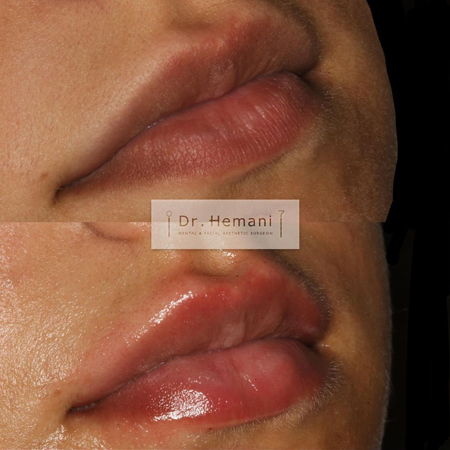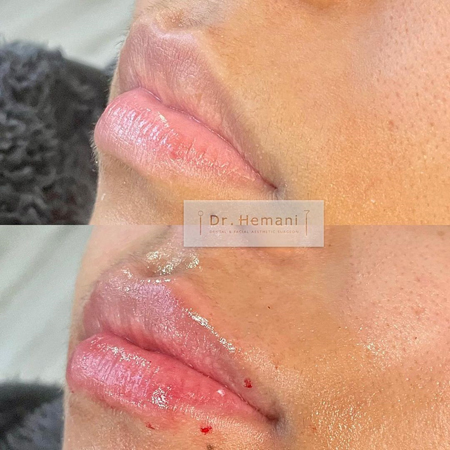
"I recently had composite bonding, Botox and filler done with Dr Hemani, and I can’t stop looking at my new smile! She was super professional and just lovely to interact with - plus such a great team that work alongside her! I am really happy with my results and I have already recommended all my friends and family. Thank you Dr. & Envy Smile."
As skin ages, both naturally and because of factors such as smoking, sun damage and poor diet, we lose collagen, fat and other natural moisturising substances from our skin. As these are depleted our skin becomes thinner and lines, wrinkles and folds develop.
Facial volume loss is one of the key factors in the ageing process, and dermal fillers can help to replenish this lost volume, and rejuvenate the face.
Dermal fillers can also be used to enhance, define, or enlarge lips, and to shape and volumise the face by injection into cheeks, chins, and nose.
Lips
Cheeks
Chin
Jawline
Temples
Nose-Mouth Lines
Marionette Lines
Tear Trough (Under Eye)
Nose
Treatment usually involves the application of local anaesthetic cream to the treated area or a nerve block similar to a dental injection.
The dermal filler is then comfortably injected into the treated area to fill out the line, wrinkle or fold. Some fillers contain an anaesthetic in them to help with any discomfort, if a nerve block has not been administered.
If you are interested in reducing wrinkles which occur through facial expression, you may find that other treatments which we offer are better suited to your needs.


Dermal fillers are injectable substances used to restore volume and enhance certain facial features. They are often used to reduce the signs of aging, such as wrinkles and sagging skin.
Dermal fillers work by adding volume to specific areas of the face, such as the cheeks, lips, and under the eyes. They can plump up areas that have lost volume over time, smoothing out wrinkles and giving the face a more youthful appearance. Some fillers also stimulate the production of collagen, a protein that improves the skin's elasticity and firmness.
There are several types of dermal fillers available, including hyaluronic acid fillers, collagen fillers, and synthetic fillers. Hyaluronic acid fillers are the most popular because they provide natural-looking results and are reversible if needed.
The duration of the results can vary depending on the type of filler used, the area treated, and individual factors. Generally, most dermal fillers last between 6 to 18 months. However, some fillers can last up to two years.
Dermal fillers are generally considered safe when performed by a trained and experienced professional. However, as with any medical procedure, there are some risks involved, such as bruising, swelling, and infection. It is important to choose a reputable practitioner and discuss any concerns or allergies you may have before the treatment.
Dermal fillers are typically injected using a fine needle or cannula, and discomfort during the procedure is minimal. Most fillers also contain a local anesthetic, such as lidocaine, which helps numb the area and minimise any discomfort. Some individuals may experience mild soreness or swelling after the treatment, which usually subsides within a few days.
Dermal fillers can be used to enhance lips, fill in deep folds and wrinkles, improve the appearance of scars, plump up cheeks, and contour the face. They can also be used to rejuvenate the hands and improve the appearance of thinning skin on the back of the hands.
Yes, dermal fillers can be used in combination with other cosmetic procedures, such as Botox injections or laser resurfacing. These complementary treatments can provide more comprehensive results and address multiple signs of aging.
The duration of a dermal filler treatment can vary depending on the areas being treated and the number of injections required. In general, the procedure can be completed in 30 minutes to an hour, and there is no downtime afterwards.
Common side effects of dermal fillers include redness, swelling, bruising, and mild pain or discomfort. These side effects are typically temporary and resolve within a few days. In rare cases, there may be more serious complications, such as infection or vascular occlusion. It is important to consult with a qualified professional and disclose any medical conditions or medications before the treatment.
The results of a dermal filler treatment are usually visible immediately after the injection. However, some swelling and bruising may occur initially, which could temporarily mask the final results. Once these side effects subside, the full effect of the filler can be appreciated.
One advantage of hyaluronic acid fillers is that they can be reversed using an enzyme called hyaluronidase. This enzyme breaks down the hyaluronic acid and can quickly dissolve the filler if necessary. The reversal process should only be performed by a trained professional.
Dermal fillers are not permanent. Over time, the body breaks down the filler material, and the effects gradually diminish. Therefore, maintenance treatments may be necessary to sustain the desired results.
Dermal fillers are generally safe for most people; however, it is important to consult with a healthcare professional to determine if they are suitable for you. Individuals with certain medical conditions, allergies, or ongoing skin infections may not be suitable candidates for dermal filler treatment.